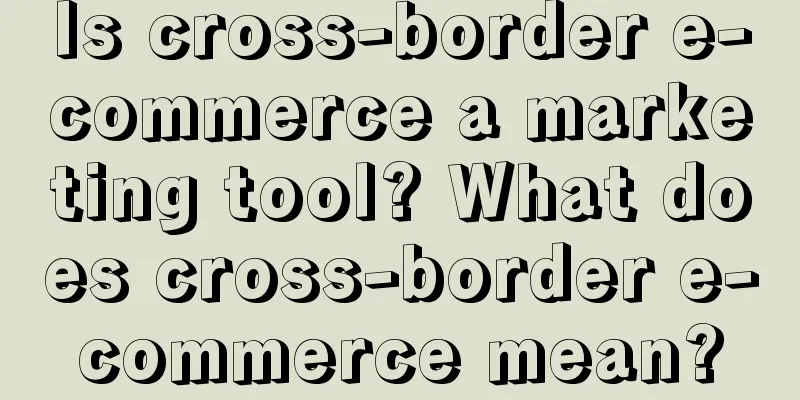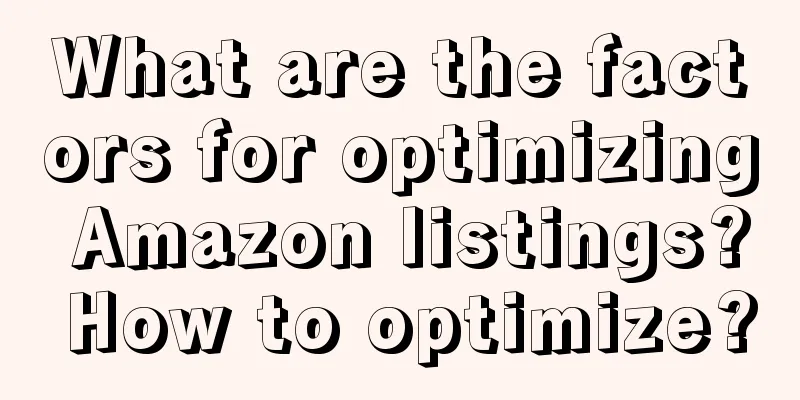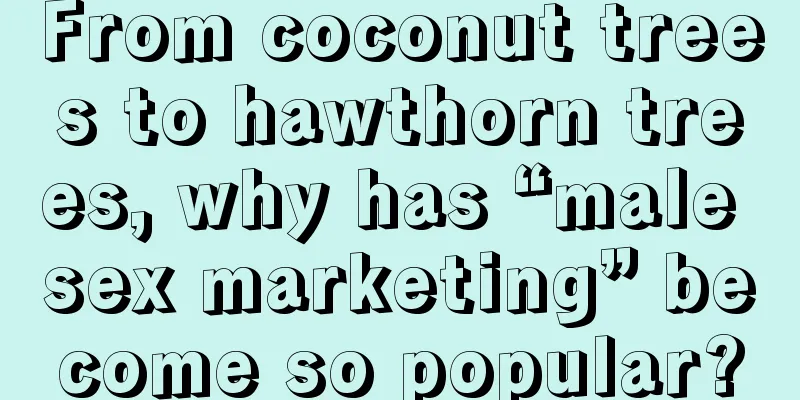I'll be frank: China's marketing has changed dramatically

This article is 5,000 words long and contains my thoughts and summaries from the past six months. I suggest you save it before reading it. This year we should have felt with our own eyes that the market is very difficult and the structural turning point has arrived. I won’t go into details about how bleak 618 is. More importantly, many people in the industry are facing difficulties: It is a commonplace that traditional brand marketing methods are no longer effective. The market share of many brands has been divided. The strategies that worked well in the past, such as spending money on saturation marketing, wholesale celebrity endorsements, and sponsorship of major variety shows, major events, and major activities, are no longer effective this year. Advertising companies are also complaining that their orders are getting smaller and smaller. The creative hot shops that used to be in their heyday are now trying to find ways to create their own second curves - some are making short plays, some are switching to private domain operations, and even an advertising company boss said he wanted to join me. The Fortune 500 companies have also started to falter. The Fortune 500 companies that were watching the new consumer brands "busy" with the two micro-blogs, Kuaizhi, and DouB have discovered that something is wrong. For example, Nike's stock price has fallen by 30% this year, and its market share has been taken away by Hoka and On. I feel bad too. I meet many companies in the upstream and downstream of the brand and marketing ecosystem every day, so I want to summarize some methods and trends for everyone and serve as a beacon. There is no need to be afraid of the truth. Every inch of progress brings joy. Not everyone is suffering. I still see many vibrant, thriving and steadily advancing companies in the market. Whether you admit it or not, I am not afraid of offending a group of people, I just want to say it directly. Marketing has changed drastically, and it is a structural change. In essence, these successful companies have grasped a key point: fully embracing the global structural transformation in the Marketing 3.0 era. The era of new marketing has already begun before us. 01 The marketing landscape is loosening and disintegrating, and the top 500 companies are beginning to embrace content e-commerceA few days ago, I attended the highest decision-making meeting of a Fortune 500 company with a market value of over 10 billion yuan, and the report was about "growth driven by global content." Car companies are also beginning to study new marketing. A large advertising company has set up a business unit specifically responsible for the global marketing of automobiles. Not only that, this year I visited several foreign companies and Fortune 500 companies to provide them with advice on their "global transformation". I can't help but sigh that, finally, after waiting for so many years, the content era has officially arrived. In 2019, I started to talk about using Weibo, WeChat, Xiaohongshu, Kuaishou, Zhihu, Douyin, and Bilibili as the core marketing strategy. New consumer brands listened very seriously, but large group brands didn't take it seriously - how much of my market share do those channels and e-commerce account for? There is nothing to be afraid of. These companies, which have historically been driven by large-scale penetration and distribution, actually believe that although content e-commerce is new, it cannot shake my huge foundation. However, since last year, the territory of large-scale penetration and distribution has begun to loosen and disintegrate. The beauty and personal care industries have long been at the forefront. For example, Hansu seized the opportunity of short drama marketing and became the number one on Douyin. The clothing category has begun to add skin care products to clothes. SINSIN, who I just talked to recently, broke the circle with a pair of shark pants that added hyaluronic acid and niacinamide. Food and beverage companies have also had to embrace content e-commerce. A snack brand worth nearly billions told me that some offline supermarket channels used to account for 80% of their sales, but now it is only 20-30%. Channels are also changing. Consumers are less and less willing to shop offline. Community group buying and O2O near-field e-commerce have replaced the original traditional supermarkets. At the same time, traditional supermarkets have also ushered in a wave of changes. For example, Walmart has transformed its on-site stores into experience and service venues. Even new channels, such as busy plums and snacks, have the shadow of new content marketing hidden behind them. After saying so much, I just want to tell you that this year's Fortune 500 companies and billion-dollar companies are all eager to embrace omni-channel content e-commerce. However, many people have only changed their means. They go to Xiaohongshu and Douyin to plant content, and they think they are embracing content e-commerce. In fact, behind this is a huge change in marketing, and the entire ecosystem needs to be reorganized. From the most obviously perceived marketing communication and channels, to the content, to the product, to consumers, to the brand core, to the business model, to marketing service agencies, and to the tools behind them, everything needs to be reorganized. I can’t finish it in one article, so I will talk about it bit by bit. 02 Super small content, super small penetration, super small wisdomFirst, let’s talk about brand marketing: In the past we would use a few key words – big creativity, big mind, and big penetration. Now these are useless, what we need is "super small content, super small intelligence, and super small penetration". What does super small content, super small intelligence, and super small penetration mean? Let me first state a point of view:
What was the marketing world like in the past? One big TVC + several big KVs. Multiple regions, multiple channels, and high-profile advertising. A bunch of bloggers produce content and then promote it with traffic. Use big ideas to create big advertisements, accumulate big minds, and leverage big distribution. Why was the logic like this in the past? Because the underlying formula behind past business was: Brand business scale = category mindshare * category channel penetration * channel sales What will the future marketing world look like that is already happening and coming soon?
A large part of the content is produced by AI, and another part is produced by KOC, and only a small part is produced by the official brand. Brand business scale = population mental penetration rate * population LTV * population fission rate In my article Advertising VS Content, I wrote that advertising is like the loudspeaker at the entrance of the village, while content is like a stereo that penetrates into your capillaries. Advertising is like a cannon, attacking indiscriminately; content is like a shotgun, suppressing at close range and hitting the target with one shot. I want to talk about a misunderstanding here. I mentioned a point in the podcast with Jiang Nanchun: many people are planting grass, but in fact they are planting weeds, or even poisonous weeds. Why? Because planting grass is not about the action itself, it is not about how many notes and posts there are, or how many broadcasts there are, but it is about what kind of people you are targeting and what mental labels you leave behind. The best way is to keep it simple. As I talked with Joanna, the former CMO of Coca-Cola, the marketing department today is doing a lot of marketing actions that seem very fancy, but in fact they have long deviated from several core issues: Who are our core consumers? Why do they use our products? In what scenarios do they use them? Who are our real enemies? Marketing has not changed since ancient times. In fact, it is all about solving consumer tasks (JTBD, job to be done). This picture comes from Zhihu @中年小佬子KC, the translation is very good, so I just paste it here. I have discussed this concept in more detail in the article "Advertising VS Content", so I won't expand on it here. But in the past, when supply was scarce, we were used to constantly exaggerating the features of our products and trying to sell them hard. For example, in some advertisements, they always promote how good my product performance is and how my product quality is first. For example, the noise pollution source of Weilong spicy strips. But a question that is often rarely addressed is “Who and why would they use my product?” For example, I talked to the boss of a company a few days ago, who makes health supplements. He told me that the customers he has found have already recognized this type of product, and he advertises that his quality is the best in this category. I asked him, these are existing customers in this category. You can only use category words in shelf e-commerce, but under the logic of content e-commerce, you need to use more than just category words. You also need to solve a scenario problem: who, and in what scenario, needs to eat your product? Who are your consumers, in what scenarios do they use you, and why do they choose you? This consumer mission is not clearly thought out and is not willing to be thought about. It is like compensating for strategic laziness with tactical diligence. If we think this issue through clearly, huge changes will occur from user-driven content to product and then to brand awareness. The issue behind this is not a problem of operational methods, but a structural transformation. It is the category positioning school where supply was originally less than demand, and has transformed into the people-oriented school where supply is greater than demand. The more you limit yourself to categories, the more you will be trapped in the existing stock. The more you start to open up and look at crowd scenes, the more potential there is. 03 From shelf e-commerce to content e-commerce is a structural transformation of enterprisesIn other words, you may think that in the Marketing 3.0 era, only the way of marketing communication has changed. Isn’t it just that the communication channel has changed from the original media to the new media? No, there are structural changes behind it. The change from "people looking for goods" to "goods looking for people" has brought about a complete transformation from the crowd, to the content, to the products, even to the bottom layer of the brand, and then to the business model. I will briefly talk about it here and then give you specific cases later. It turns out that the logic behind people looking for goods is clear demand + shelves + categories. For example, if my toothpaste is almost gone and I need to restock it today, I can either go directly to an offline supermarket, find the toothpaste shelf, pick up a bottle and pay for it, or open Taobao, search for the keyword "toothpaste", and place an order directly. Taobao is an online virtual shelf. But you will soon find that the category words are rising, and the number of people who need the category is so small. With the expensive and small category volume, there is a red ocean of involution within the category. Someone has calculated that the GMV of Douyin e-commerce will be about 1.5 trillion in 2022, 2.7 trillion in 2023, and the target for 24 is 4 trillion; Taobao's GMV will be 8.3 trillion in 2022 and 7 trillion in 2023. It is obvious how big the impact of Douyin is on Taobao. The reason behind this is that "goods find people" is about to outperform "people find goods". The future will definitely be a world driven by both content e-commerce and shelf e-commerce, but the power of content will precede the shelf. Because content is the logic of shopping, and shelves are the logic of problem solving. In the logic of content e-commerce, goods find people based on crowd logic. One piece of content can reach millions of people. No matter whether you have demand or not, as long as people see it, I can find a way to sell things to you. According to shelf logic, toothpaste can only be sold to people who need it. Once demand is saturated, growth will disappear. According to crowd logic, you can sell the toothpaste to people who think it looks good, smells good, is fun, like the spokesperson, or even those who are just bored and ordering out of boredom. As long as you can stimulate underwater demand, sales can increase tenfold or a hundredfold. This is why I emphasize global content marketing: In the new battlefield of content e-commerce, we must reorganize and innovate the crowd, scenarios, products, content, and marketing strategies, and redefine resource allocation and organizational structure, so as to usher in a structural transformation of growth. For example, a few days ago I talked about a mature brand that makes traditional pastries. Its brand recognition is that of a travel gift. Originally, most of its sales were offline, but in the past two years it has also started selling online, but its sales are still to those people who know them because of traveling. This approach is nothing more than moving the shelves online, adding an additional ordering channel, but the growth ceiling is still limited. If you want to break the ceiling and achieve a leapfrog growth from 100 million to 1 billion or 10 billion, you cannot just regard online as a channel. Instead, you must make a comprehensive transformation from positioning to products to content for new groups of people. In essence, you need to redefine JTBD. Only by redefining the core groups and scenarios based on the logic of content e-commerce and promoting new products and new positioning can we break away from the original category competition and move from a finite game to an infinite game. 04 From centralization to decentralization, it is a people-oriented equal rights dividendThe change in consumption is fundamentally a change in people. Consumers have sovereignty. The original domestic market was created from scratch. Those who controlled resources controlled the mind. People had limited choices, and shelves, advertising space, and goods were scarce. Those who controlled resources controlled the market. You have to buy it, otherwise it will be useless. There are only these advertising media, CCTV and large outdoor advertisements. There are only these celebrities. But now we have entered the era of equal rights, whether consumers choose you or not is the key. Only those who really capture people's hearts can have the market. The number of brands has reached saturation, and consumers have more choices. The relationship between brands and consumers is equal, and sometimes the brands are even lower. There are so many more media platforms and KOLs. I trust the KOLs and KOCs around me more than I trust celebrities. Celebrities are not useless. They are just eyeballs, but it does not mean that celebrity endorsements are necessarily of high quality. We believe that word of mouth is more important than advertising. We are more inclined to spontaneously seek out ordinary people like ourselves who can represent our values, provide us with emotional value. In the era of equal rights, the rights of the new group of people are that I decide my own life. Buying things is not because "you are good", but because "I am happy and it has something to do with me". Brands need to do two things well: say what they want to hear in a way that they accept. The way the new group is accepted is, to put it simply, equality. The new generation no longer believes in information from authoritative platforms. They may not necessarily think that something is good as others say or generally recognized as good. You can't educate, you can't shout, and you can't tell people you should do something. Only subtle influence can be effective. This is also why KOC is rising now, because now people like to watch stories of amateurs, ordinary people like themselves. What a brand needs to do is to translate its brand story into thousands of different stories, let different people help you tell them, and penetrate the minds of users in all circles. In order to say what they want to hear, the prerequisite is to grasp and hit the needs of new groups. But the key point is that people are now divided into groups with countless values. Maslow's hierarchy of needs divides needs into seven levels from bottom to top: food and clothing needs, sense of security, love and belonging, sense of respect, cognitive needs, aesthetic needs, and self-actualization. In general, the needs of the whole society are definitely going up. There is too much to say here. When we take a specific group of people, we will find that whether they are going up in Maslow's hierarchy or not, they still have different needs for "love and belonging". Today, it is too general to talk about the post-90s crowd. We need to analyze and summarize the motivations behind it. For example, Xiaohongshu recently released 20 major crowds, and there are 12 major crowds for outdoor sports alone. Its segmentation method is also very special, which is related to lifestyle. For example, the crowd in the outdoor track, its starting point for analysis is "what does nature mean to you", not just looking at which category you buy. I strongly agree that in the content e-commerce environment, the division of the population should not be based on demography, but sociology. China has a population of 1.4 billion, and no market is small. No matter what level of demand you are targeting, you can find a huge audience. So I said that the future Chinese market may not necessarily see P&G again, but there will be countless super crowd brands like lululemon. 05 The local brand and marketing methodology in contemporary China is imminentIn the final analysis, there is one thing that I always think about late at night. I have read all the books on brand marketing, have been in marketing for more than 10 years, have lived in various countries, and have done marketing in different categories. The market management we learned in marketing classes, the marketing taught by Procter & Gamble and Unilever, and the marketing done by the local Chinese positioning schools to this day are actually all based on overseas marketing theories - Kotler's "Market Management" and Trout's "Positioning". Those were all invented by foreigners, and are imported products. They are not necessarily completely applicable to the current Chinese market! (It’s not that they are completely unreasonable. After all, they are the ancestors, and there are still many high-level underlying assumptions.) I can say without any shame that China's marketing theory today should be defined by us Chinese! It has only been a short time since China's reform and opening up. From a shortage of supply to today's oversupply, it needs to be quickly updated. Our Chinese digital ecosystem has long been ahead of the world! How to express to consumers, create products, and innovate brands should be defined by us Chinese. In fact, in my opinion, the previous market brand marketing can be roughly divided into two stages: the slogan school in the 1.0 era and the 4A storytelling school in the 2.0 era. The 1.0 era was opened by the Chinese local sloganeering school. Based on the "positioning" theory, they found a point that could be hit, turned it into a very easy-to-understand sentence, added a super large logo with a strong visual effect, and then continuously bombarded the external world with output. Mainly in the 1.0 era, Chinese products were scarce, and the first generation of Chinese "local" bosses did not understand what a brand was. So the positioning school emerged and told the bosses to have a super symbol, a big slogan, and a big KV - a three-piece set. In the 1.0 era, you have to stick to your positioning and use these three things to occupy scarce stars, limited advertising space (such as CCTV), and limited shelves (such as offline), and then you can occupy limited minds. Later, no one wanted to listen to this simple and crude way of communication, so it was time to start telling stories, and it was time to enter the 2.0 brand story era. In the 2.0 era, you need to focus on your big idea and produce a whole set of big ideas, big advertisements, and big stories. Many Fortune 500 groups started out with brand stories. They went to China together with 4A companies, discussed with 4A advertising companies based on the underlying brand identification and product benefits of new products, and extended them into a core big idea. They then created a series of content combinations around this story. Also in line with this 2.0 era, a large number of creative people have found their own talents, and individual creative abilities were born with "Mad Men". But this method is no longer useful. People don’t want to hear brands tell stories from a high position. They tell stories in a general way and don’t make any sense. After talking about brands for a long time, I don’t know what use it is to me. In an age where people are divided into groups, if you target everyone, you target no one. If you want everyone, you will end up hitting no one. Professor Lu Taihong said in his book "A Brief History of Brand Thought" that brand theory often appears 100 years later than practice. We cannot wait for theory, we must summarize true knowledge from practice. What I have repeatedly said above is actually one thing: China's native branding and marketing strategies have actually undergone fundamental changes in the digital environment. I think we have now entered a new marketing era, 3.0. Several qualitative changes have taken place: 1. Consumers are sovereign—not brand suppliers 2. Content is the core communication medium—not advertising 3. Digitalization becomes a core tool, everything can be measured - not a black box 4. Marketing focuses on growth-driven marketing rather than just exposure 5. Fragmented screen, decentralization as the core method - not centralization 6. Media and channel integration, brand-effect integration – not brand-effect separation This wave has just begun, and the 3.0 marketing era is about to officially begin. In the 3.0 marketing era defined by our knife skills, the following changes will occur: 1. Many brands targeting different groups and scenarios have emerged and blossomed everywhere 2. The original advertising agency’s big ideas will no longer be sold, and what is needed is content strategy 3. Future content will be AI-driven, but human insight is still necessary 4. Crowd insights are back in the market, but a more scientific and digital approach is needed 5. The so-called combination of big data and deep insights, the combination of art and science is the essence of marketing Author: Siete, WeChat public account: Daojie doris |
<<: The good news is that the advertising fees in the drama market are back again!
Recommend
How does Shopee Malaysia set prices? Shopee pricing method
Friends who do cross-border e-commerce should all ...
How often is Amazon IPI updated? What is it?
There are now a lot of merchants opening stores on...
The “stolen” Guka business
As a new decorative fashion, "Guka" has ...
Even in the worst of times, there will always be excellent companies | Interview with marketing expert Zhou Hongqi
Marketing changes in the new era are surging. From...
Is it difficult to get an eBay business store? What are the models?
If you want to join eBay, you can join through two...
Are Taiwan Shopee transactions conducted in US dollars? How are prices determined?
Shopee e-commerce platform has a Taiwan site. Afte...
TikTok North American e-commerce, rising amidst the variables
At the beginning of this year, TikTok e-commerce h...
Is a foreign trade salesperson a salesperson? Is it easy to do this?
When we talk about foreign trade, we often think o...
Will Amazon limit traffic after a few warnings? How to avoid downgrading traffic?
When doing cross-border e-commerce on Amazon, you ...
Xianyu launches "seafood perfume"; 1 point gives away wooden fish; Adidas uses shoe boxes as shoes... This is how you should do April Fools' Day marketing!
April Fools' Day is a great opportunity for br...
Brand No. 1: 24 business rules
To build a brand, you also need to understand busi...
All of these are true! 80% of the success of private domain depends on execution, and 20% is luck
In the field of private domain traffic management,...
It’s time for Xiaohongshu to focus on store broadcasting
This article deeply analyzes Xiaohongshu's new...
Shopee Malaysia will stop withdrawing money to banks through ShopeePay
According to the Shopee Malaysia Help Center, the ...
How to choose brands and categories for cross-border e-commerce without source of goods?
As a flexible and low-cost business model, cross-b...









